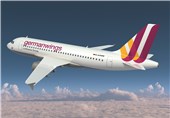Germanwings Pilot Rehearsed Crash on Outbound Flight
TEHRAN (Tasnim) – The Germanwings co-pilot suspected of deliberately crashing a jet in the French Alps rehearsed the fatal maneuver on the morning of the disaster, and had twice been refused medical papers needed to fly, investigators said on Wednesday.
The French BEA accident investigation agency said the co-pilot had five times set the autopilot to take the Airbus down to just 100 feet while the captain was out of the cockpit on the outbound flight to Barcelona from Duesseldorf.
But the brief twists of an altitude dial, mimicking those which crashed the A320 on its way back to the German city 2-3 hours later, would not have been noticed by passengers or controllers because they were quickly reversed and were masked by the fact that the jet had already started an authorized descent, the BEA said.
A preliminary report on the return flight that crashed on March 24, killing all 150 people on board, confirmed a growing picture of painstaking preparations carried out by the co-pilot, Andreas Lubitz, Reuters reported.
"I can't speculate on what was happening inside his head; all I can say is that he changed this button to the minimum setting of 100 feet and he did it several times," said Remi Jouty, director of the French BEA accident investigation agency.
"These very brief actions on the previous flight were a sort of rehearsal of the maneuver," he said.
Digging into data and cockpit recordings recovered from the jet's "black boxes", the BEA gave the most detailed picture so far on what happened in the cockpit of return flight 9525.
The 27-year-old co-pilot was in charge of flying the plane on the return leg, a routine practice that allows pilots to build up experience.
Shortly after the A320 reached cruise height, the captain told Lubitz he was leaving the cockpit and asked him to take over the radio, the BEA said. No reason was given, but Jouty noted it is normal for pilots to leave the cockpit to go to the toilet, for example.
Just over 30 seconds after the door closed, leaving Lubitz alone in the cockpit for the second time that day, he entered the instruction he had rehearsed.
By turning a dial, he ordered the plane's autopilot to descend to 100 feet, the BEA said. This was the lowest setting possible and enough to crash into mountains ahead. He then altered another dial to speed the jet up.
The report listed numerous warnings that went unanswered as the jet sped lower. These included four attempts to reach him from outside the cockpit by interphone and a crescendo of calls and knocks that ended with "violent blows" on the door.
As the jet steadily lost height, Marseille air traffic controllers tried 11 times to contact the Germanwings jet.
Just over two minutes before the crash the French military weighed in, trying three times to contact the crew on an emergency frequency, followed by a call from another plane.
Finally the aircraft's ground-proximity warning system kicked into life, urging the co-pilot to "pull up".
Many airlines have recently made it compulsory to have two people in the cockpit to help prevent accidents, but Jouty said accident records suggested this would not be an automatic cure.






